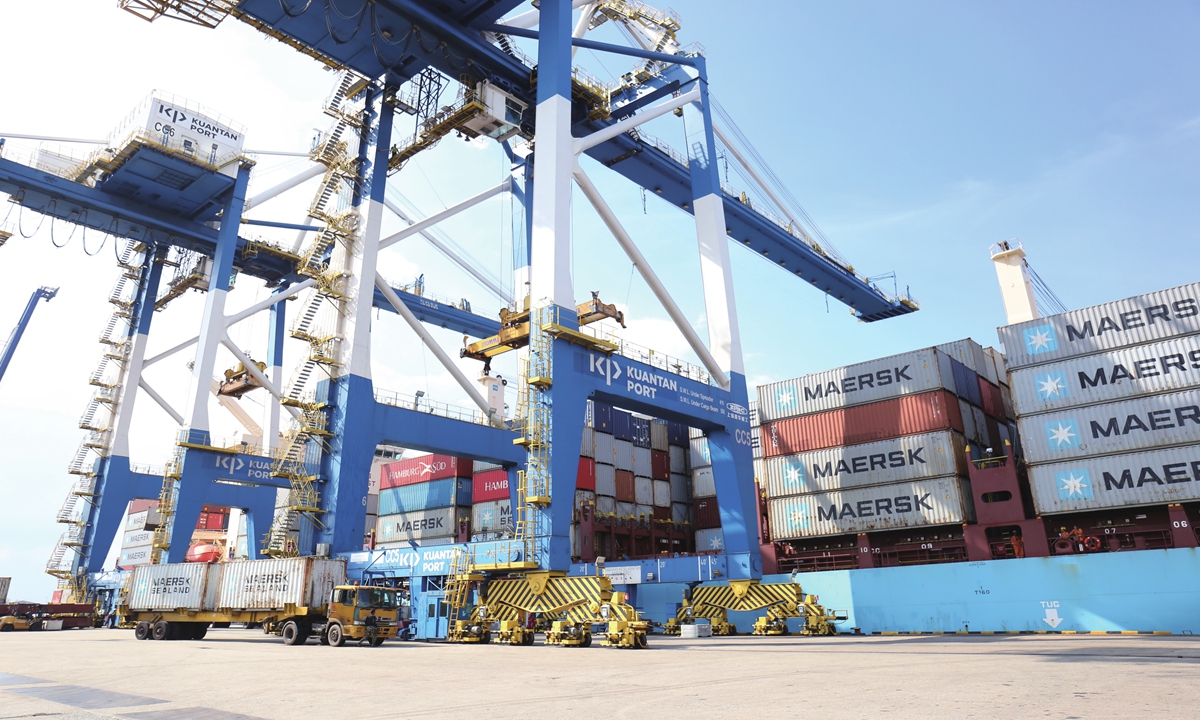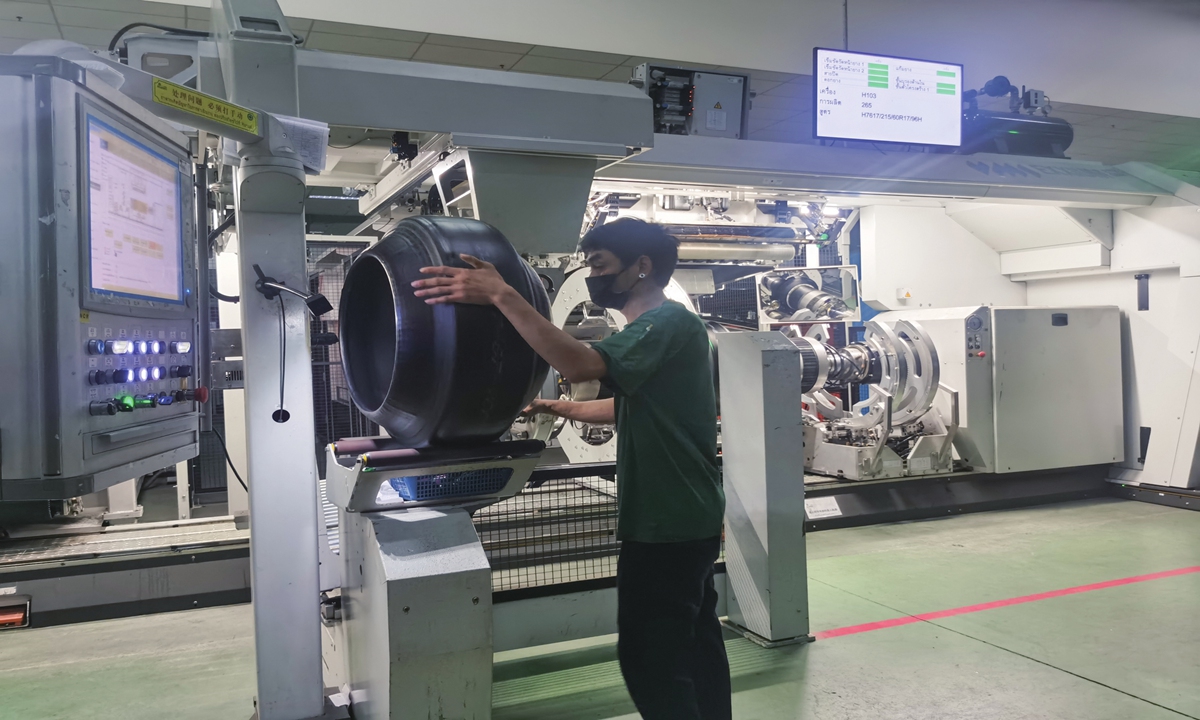
Malaysia's Kuantan Port Photo: He Zhuoqian/GT
"In Malaysia, For Malaysia" is a phrase printed on the business card of Hu Jiulin, the chief technology officer of Alliance Steel, the largest steel plant in the country, also one of the first Chinese companies to establish a plant within the Malaysia-China Kuantan Industrial Park (MCKIP), located on the east coast of Malaysia.
Over the past decade, Hu Jiulin has witnessed how their office emerged from a swampy area to become part of a densely populated commercial area which has unlocked significant economic value for local residents.
Hu Jiulin told the Global Times that based on their strength in production capacity, Alliance Steel has helped Malaysia which is transforming from a steel importing country to an exporting country.
Hu thanked for the Belt and Road Initiative (BRI), as the China-proposed initiative encourages Chinese companies with core competencies to expand overseas into countries along the BRI route.
The case of Alliance Steel embodies China's capacity to work closely with ASEAN members under the framework of the BRI. Through complementary advantages and resource allocation, numerous Chinese companies are exploring the Southeast Asian market for new opportunities, often boosting the technological innovation and efficiency of local market participants.
Leveraging complementary advantagesAlliance Steel's Malaysian factory entered operation in 2018 with its current annual capacity reaching over 4 million tons, with many calling it a symbol of "Chinese speed."
ASEAN members with growing demand in infrastructure represent emerging opportunities for a number of high performing Chinese industries such as the steel sector.
"Steel production has become strength of Chinese companies based on advantages in environmental protection and technology," said Hu Jiulin.
The South East Asia Iron and Steel Institute (SEAISI) stated that steel demand in 6 members of the ASEAN- in 2023 is projected to increase by 3.4 percent year-on-year to 77.6 million tons, after rising by 0.3 percent in 2022. The major drivers of the growth in steel demand in the region will be Indonesia and the Philippines.
Inside the MCKIP, a logistic park is now under construction. With a total investment of $300 million, the logistic park is jointly developed by China Harbour Engineering Company, Malaysian company IJM and Beibu Gulf Port Group, and is envisioned to be a comprehensive park that integrates international manufacturing and logistics services.
"We plan to build it into an industrial and economic cooperation demonstration zone for China and Malaysia, and also for China and ASEAN," Wan Yu, CEO of Malaysia-China Kuantan International Logistic Park, told the Global Times.
Wan said the industrial park is being built to serve the needs of international companies who are either seeking to diversify certain parts of their supply chain amid the reconstruction of global supply chain, or who are pursuing accelerated global expansion with Malaysia as a central node.
The ambition of Chinese companies fits perfectly with the economic development strategies of several ASEAN members.
Zhongce Rubber (Thailand) Company, located in the Thai-Chinese Rayong Industrial Zone in Thailand, produces over 20 million tire component units each year following several rounds of expansion since 2015.
Chen Hua, the general manager of the company, told the Global Times that Thailand itself is the center of the Southeast Asian automotive manufacturing industry, and with the development of the new-energy vehicle industry in the region, demand for tires is set to increase further.
Viewed as offering "good quality at a low price," Chinese tires have been increasingly popular among auto makers, with Southeast Asia proving to be a key market.
As a pillar industry, automotive manufacturing in Thailand accounts for about 10 percent of the country's total industrial output and employs about 10 percent of the country's manufacturing workforce.
Zhao Bin, president of the Thai-Chinese Rayong Industrial Realty Development Co., has been a witness to "Chinese advantages" coupling with "Thai demand."
Zhao told the Global Times that the Thai-Chinese Rayong Industrial Zone accommodates nearly half of China's manufacturing companies invested in Thailand.
The companies that moved into the industrial zone in the early stage have been mainly focused on automotive parts and fiber optic communication, with subsequent firms including photovoltaic manufacturing and electronic components, showing significant improvements in both scope and quality, Zhao noted.
The development of similar parks represents the integration of Chinese and Thai economic strategies. In 2013, the China proposed the BRI, which aligns with the Thai government's "Thailand 4.0 strategy" and "Eastern Economic Corridor plan." The Thai-Chinese Rayong Industrial Zone is located in the core area of the "Eastern Economic Corridor."
Zhao said that the BRI plays an important role in promoting Chinese investment in Thailand. When the Thai-Chinese Rayong Industrial Zone was first established in 2006, there were only five or six new enterprises entering the park each year. However, after 2013, the number of new firms saw a marked increase. To date, 70 percent of the Chinese firms invested in Thailand have done so under China's BRI.
In addition, since 2013, more emerging industries including new energy, electronics and electrical appliances, medical enterprises have been at the forefront of new investment.
In the first six months of 2023, applications totaled 364.4 billion baht ($10.37 billion) and foreign direct investment surged 141 percent year-on-year to 304 billion baht, the Thai Board of Investment confirmed in a statement. China was the country's major investor, with projects worth 61.5 billion baht, Reuters reported on July 10.

A Thai employee works at a factory of Zhongce Rubber (Thailand) Company, located in the Thai-Chinese Rayong Industrial Zone, in Thailand. Photo: Hu Yuwei/GT
Creating employment, skills and valuesHu Ke, Investment and Development Director of Beibu Gulf Port Group (Malaysia), told the Global Times that that MCKIP, a landmark BRI project located at Kuantan, has delivered positive effects into the local economy.
The Kuantan industrial park, which is under the new model of international cooperation, "Two Countries, Twin Parks," was inaugurated ten years ago. The park, along with its Chinese counterpart, the China-Malaysia Qinzhou Industrial Park located in Qinzhou, South China's Guangxi Zhuang Autonomous Region, is a cooperation project between the governments of China and Malaysia.
"Chinese companies have brought technologies and investment in the past years, which in turn drives the development of downstream and upstream industries, improves the skills of local workforce and elevates the GDP of Pahang state, where Kuantan is located," she said.
Investments from Chinese companies have also fueled cargo handling capacity at nearby Kuantan Port, a major trading hub on the East Coast Economic Region of Peninsular Malaysia which serves as a gateway for manufacturing firms to export products overseas, Hu Ke noted.
MCKIP's development also leads to a host of employment opportunities, creating around 20,000 jobs.
Similar training and technology transfer is also taking place during the construction of the Jakarta-Bandung High-Speed Railway (HSR), which is expected to be operational later this year.
Elizabeth, the safety manager at the Tegalluar Station construction site for the Jakarta-Bandung HSR project, told the Global Times that she now has a deep understanding and appreciation of the safety standards put in place by Chinese companies for high-speed rail construction. She noted that this advanced knowledge and skills have become valuable forms of work experience and will help to further her career.
Locals across ASEAN recognize the tangible benefits delivered to their own countries through the BRI cooperation.
"In the past, most ASEAN members used to draw upon the Western development path, relying on a resource-driven model to propel their economies. But such a path of development is not sustainable," Wirun Phichaiwongphakdee, director of the Thailand-China Research Center of the BRI and Researcher at the Thailand-China Strategic Research Center at the National Research Institute of Thailand told the Global Times.
"Most ASEAN members, which are also developing economies, lack complete industrial chains and manufacturing systems. But the rise of China and its various global initiatives have illuminated a unique model that is perfectly applicable to other Asian economies."





